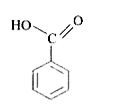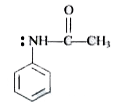In which of the following compounds delocalisation of electrons and shifting of electron in the same direction ?

The correct Answer is:B, C
To solve the question regarding the delocalization of electrons and the shifting of electrons in the same direction for the given compounds, we will analyze each compound step by step.
Step 1: Analyze Compound A (Phenol)
- Structure: Phenol has a hydroxyl group (-OH) attached to a benzene ring.
- Delocalization: The lone pairs on the oxygen can participate in resonance with the aromatic ring. This results in electron delocalization towards the ring.
- Shifting: The electronegativity of oxygen causes the electrons to shift towards it. Thus, the direction of electron shifting is towards the oxygen.
- Conclusion: Delocalization is towards the ring, and shifting is towards the oxygen. They are in opposite directions. Not the correct option.
Step 2: Analyze Compound B
- Structure: This compound has a methyl group (CH3) attached to a nitrogen (NH) which is conjugated with an electron-withdrawing nitro group (NO2).
- Delocalization: The lone pair on nitrogen can delocalize towards the nitro group due to resonance.
- Shifting: Since the nitro group is electron-withdrawing, the electron density shifts towards it as well.
- Conclusion: Both delocalization and shifting are in the same direction (towards the nitro group). This is a correct option.
Step 3: Analyze Compound C
- Structure: This compound has a conjugated system with double bonds and a nitro group.
- Delocalization: The electrons can delocalize through the double bonds towards the nitro group.
- Shifting: The nitro group being electron-withdrawing will also cause the electron density to shift towards it.
- Conclusion: Both delocalization and shifting are in the same direction (towards the nitro group). This is also a correct option.
Step 4: Analyze Compound D
- Structure: This compound has an amine group (NH2) attached to a carbon chain.
- Delocalization: The lone pair on the nitrogen can delocalize towards the carbon chain.
- Shifting: However, since nitrogen is more electronegative, the electron density will shift towards nitrogen.
- Conclusion: Delocalization is towards the carbon chain, while shifting is towards nitrogen. They are in opposite directions. Not the correct option.
Final Answer
The compounds in which delocalization of electrons and shifting of electrons are in the same direction are Compound B and Compound C.
- Structure: Phenol has a hydroxyl group (-OH) attached to a benzene ring.
- Delocalization: The lone pairs on the oxygen can participate in resonance with the aromatic ring. This results in electron delocalization towards the ring.
- Shifting: The electronegativity of oxygen causes the electrons to shift towards it. Thus, the direction of electron shifting is towards the oxygen.
- Conclusion: Delocalization is towards the ring, and shifting is towards the oxygen. They are in opposite directions. Not the correct option.
- Structure: This compound has a methyl group (CH3) attached to a nitrogen (NH) which is conjugated with an electron-withdrawing nitro group (NO2).
- Delocalization: The lone pair on nitrogen can delocalize towards the nitro group due to resonance.
- Shifting: Since the nitro group is electron-withdrawing, the electron density shifts towards it as well.
- Conclusion: Both delocalization and shifting are in the same direction (towards the nitro group). This is a correct option.
- Structure: This compound has a conjugated system with double bonds and a nitro group.
- Delocalization: The electrons can delocalize through the double bonds towards the nitro group.
- Shifting: The nitro group being electron-withdrawing will also cause the electron density to shift towards it.
- Conclusion: Both delocalization and shifting are in the same direction (towards the nitro group). This is also a correct option.
- Structure: This compound has an amine group (NH2) attached to a carbon chain.
- Delocalization: The lone pair on the nitrogen can delocalize towards the carbon chain.
- Shifting: However, since nitrogen is more electronegative, the electron density will shift towards nitrogen.
- Conclusion: Delocalization is towards the carbon chain, while shifting is towards nitrogen. They are in opposite directions. Not the correct option.
The compounds in which delocalization of electrons and shifting of electrons are in the same direction are Compound B and Compound C.
Topper's Solved these Questions
- GENERAL ORGANIC CHEMISTRY-IBOOK - RESONANCE ENGLISHCHAPTER - GENERAL ORGANIC CHEMISTRY-IEXERCISE - EXERCISE-2 PART-IV : COMPREHENSION
5 Videos
- GENERAL ORGANIC CHEMISTRY-IBOOK - RESONANCE ENGLISHCHAPTER - GENERAL ORGANIC CHEMISTRY-IEXERCISE - EXERCISE-3
11 Videos
- GENERAL ORGANIC CHEMISTRY-IBOOK - RESONANCE ENGLISHCHAPTER - GENERAL ORGANIC CHEMISTRY-IEXERCISE - EXERCISE-2 PART-II SINGLE AND DOUBLE VALUE INTEGER TYPE
11 Videos
- GENERAL ORGANIC CHEMISTRY IIBOOK - RESONANCE ENGLISHCHAPTER - GENERAL ORGANIC CHEMISTRY IIEXERCISE - Part-III: Section-5: Matching List Type
1 Videos
- HYDROGEN AND ITS COMPOUNDSBOOK - RESONANCE ENGLISHCHAPTER - HYDROGEN AND ITS COMPOUNDSEXERCISE - INORGANIC CHEMISTRY(Hydrogen & its compunds Y environment chemistry)
33 Videos
Similar Questions
Knowledge Check
Which of the following compounds will create electron at ortho and para greater than
 A
A B
B C
C D
D
Which of the following compounds have electron deficiency at ortho and para positions?
A B
B C
C D
D
In which of the following carbocations, delocalisation of positive charge is possible :
View SolutionWhich of the following is electron deficient?
View SolutionWhich of the following is electron deficient ?
View SolutionIn which of the following compound, chlorinie exerts the maximum number of electronic effects ?
View SolutionTwo streams of electrons are moving parallel to each other in the same direction. They
View SolutionWhich of the following pair is iso-electronic : -
View Solution
